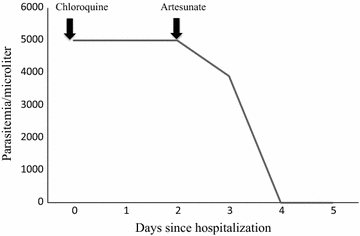Severe Plasmodium ovale malaria complicated by acute respiratory distress syndrome in a young Caucasian man
- PMID: 29609605
- PMCID: PMC5879577
- DOI: 10.1186/s12936-018-2289-2
Severe Plasmodium ovale malaria complicated by acute respiratory distress syndrome in a young Caucasian man
Abstract
Background: Although Plasmodium ovale is considered the cause of only mild malaria, a case of severe malaria due to P. ovale with acute respiratory distress syndrome is reported.
Case presentation: A 37-year old Caucasian man returning home from Angola was admitted for ovale malaria to the National Institute for Infectious Diseases Lazzaro Spallanzani in Rome, Italy. Two days after initiation of oral chloroquine treatment, an acute respiratory distress syndrome was diagnosed through chest X-ray and chest CT scan with intravenous contrast. Intravenous artesunate and oral doxycycline were started and he made a full recovery.
Conclusion: Ovale malaria is usually considered a tropical infectious disease associated with low morbidity and mortality. However, severe disease and death have occasionally been reported. In this case clinical failure of oral chloroquine treatment with clinical progression towards acute respiratory distress syndrome is described.
Keywords: ARDS; Chloroquine failure; Malaria; Plasmodium ovale.
Figures



Similar articles
-
A case of severe Plasmodium ovale malaria with acute respiratory distress syndrome and splenic infarction in a male traveller presenting in Italy.Malar J. 2024 Apr 4;23(1):93. doi: 10.1186/s12936-024-04911-4. Malar J. 2024. PMID: 38575935 Free PMC article.
-
Acute respiratory distress syndrome in a case of Plasmodium ovale malaria.Am J Trop Med Hyg. 2008 Sep;79(3):391-3. Am J Trop Med Hyg. 2008. PMID: 18784231
-
Acute respiratory distress syndrome and Plasmodium ovale malaria.Travel Med Infect Dis. 2019 Mar-Apr;28:113-114. doi: 10.1016/j.tmaid.2018.06.002. Epub 2018 Jun 7. Travel Med Infect Dis. 2019. PMID: 29886120 No abstract available.
-
Acute lung injury and acute respiratory distress syndrome in malaria.J Vector Borne Dis. 2008 Sep;45(3):179-93. J Vector Borne Dis. 2008. PMID: 18807374 Review.
-
Management of malaria: recent trends.J Commun Dis. 2006 Mar;38(2):130-8. J Commun Dis. 2006. PMID: 17370675 Review.
Cited by
-
Albumin levels in malaria patients: a systematic review and meta-analysis of their association with disease severity.Sci Rep. 2024 May 3;14(1):10185. doi: 10.1038/s41598-024-60644-z. Sci Rep. 2024. PMID: 38702420 Free PMC article.
-
Ultrasensitive electrochemical genosensors for species-specific diagnosis of malaria.Electrochim Acta. 2022 Oct 10;429:140988. doi: 10.1016/j.electacta.2022.140988. Electrochim Acta. 2022. PMID: 36225971 Free PMC article.
-
Epidemiological, Physiological and Diagnostic Comparison of Plasmodium ovale curtisi and Plasmodium ovale wallikeri.Diagnostics (Basel). 2021 Oct 14;11(10):1900. doi: 10.3390/diagnostics11101900. Diagnostics (Basel). 2021. PMID: 34679597 Free PMC article. Review.
-
A case of severe Plasmodium ovale malaria with acute respiratory distress syndrome and splenic infarction in a male traveller presenting in Italy.Malar J. 2024 Apr 4;23(1):93. doi: 10.1186/s12936-024-04911-4. Malar J. 2024. PMID: 38575935 Free PMC article.
-
Molecular Identification and Characterization of Plasmodium ovale curtisi in Field Isolates from Symptomatic Children in North-Central Nigeria.Acta Parasitol. 2021 Sep;66(3):915-924. doi: 10.1007/s11686-021-00350-2. Epub 2021 Mar 12. Acta Parasitol. 2021. PMID: 33710479
References
-
- WHO . Guidelines for the treatment of malaria. 3. Geneva: World Health Organization; 2015. - PubMed
Publication types
MeSH terms
Substances
Grants and funding
LinkOut - more resources
Full Text Sources
Other Literature Sources
Medical

